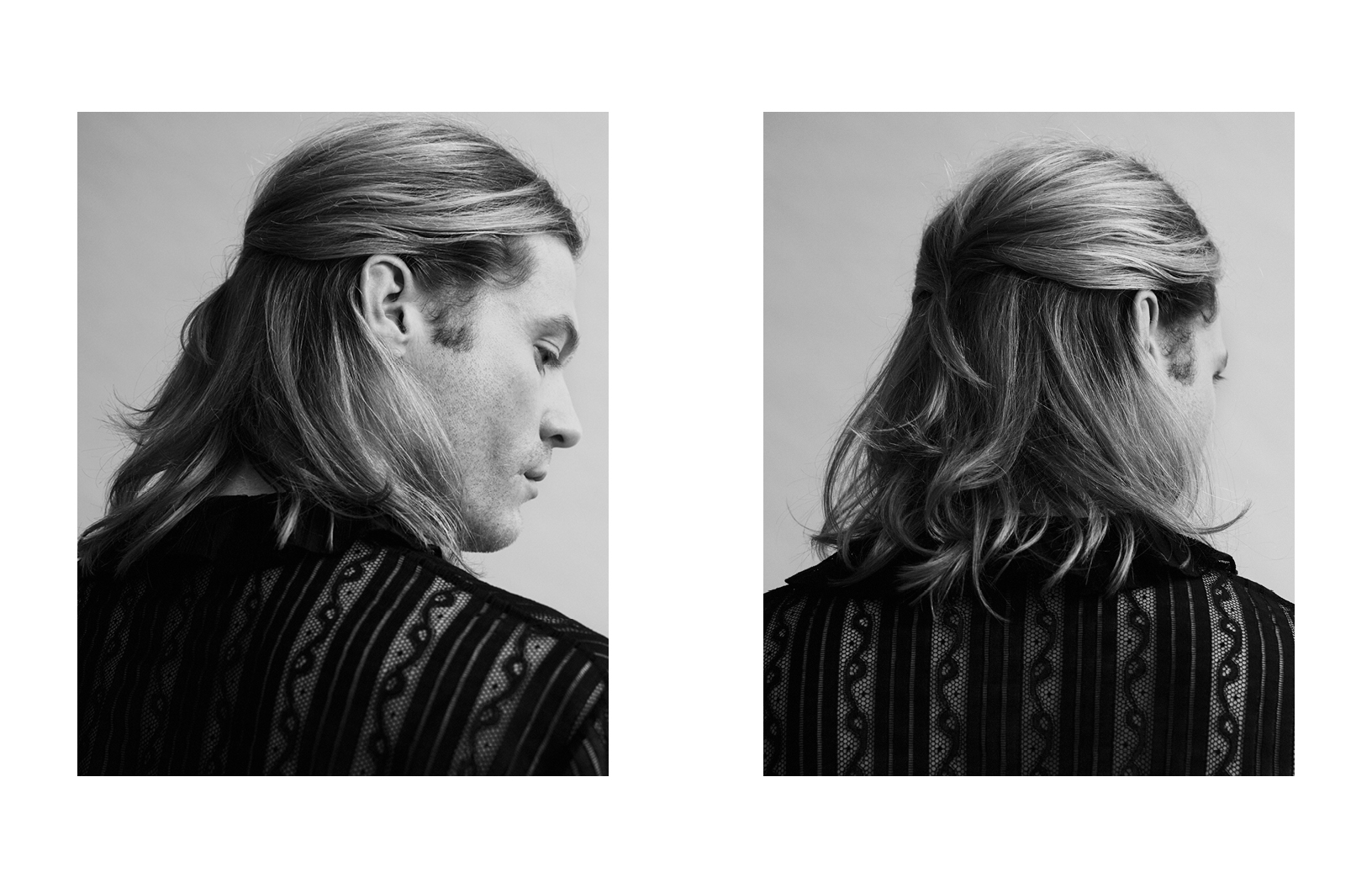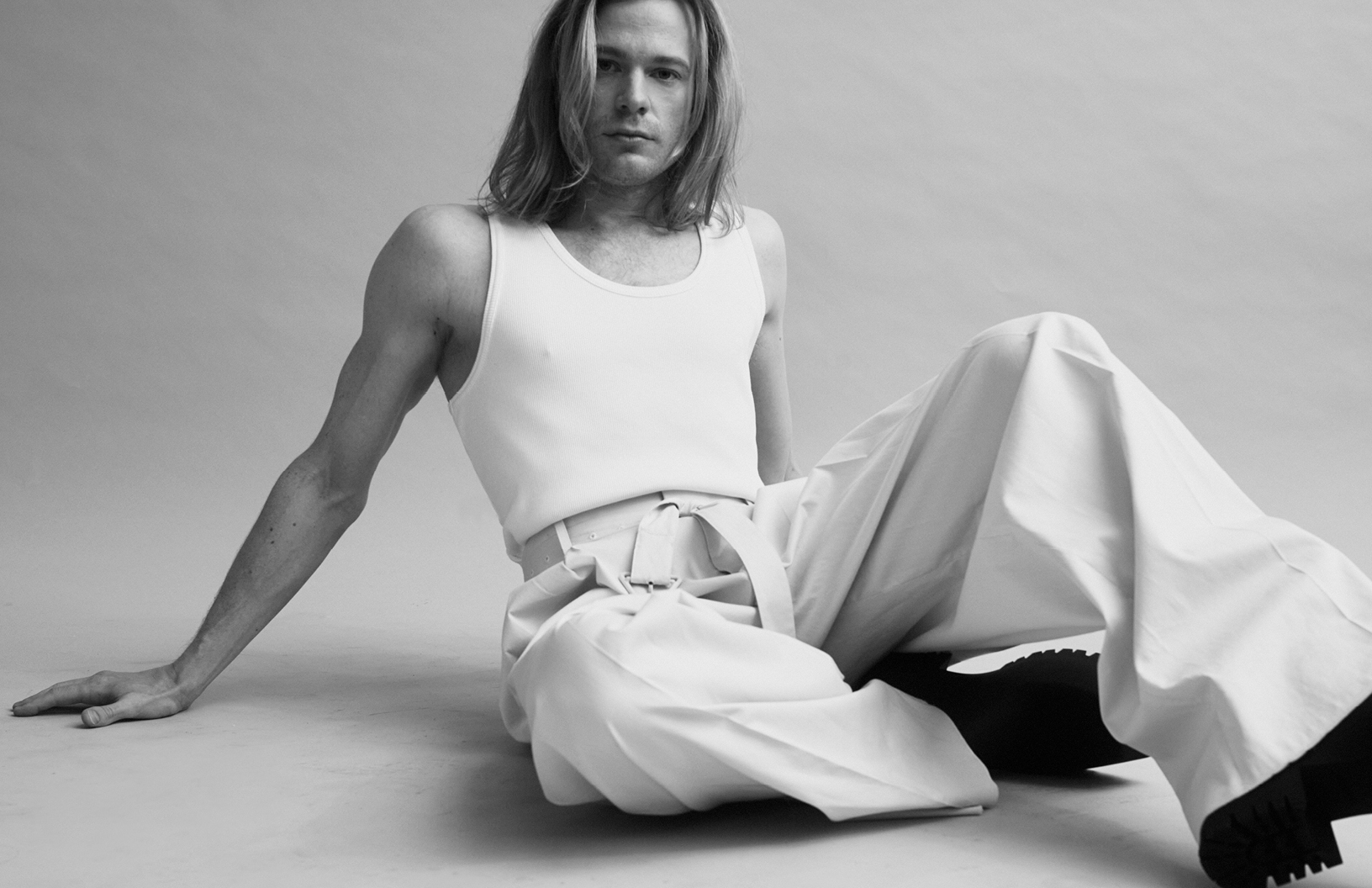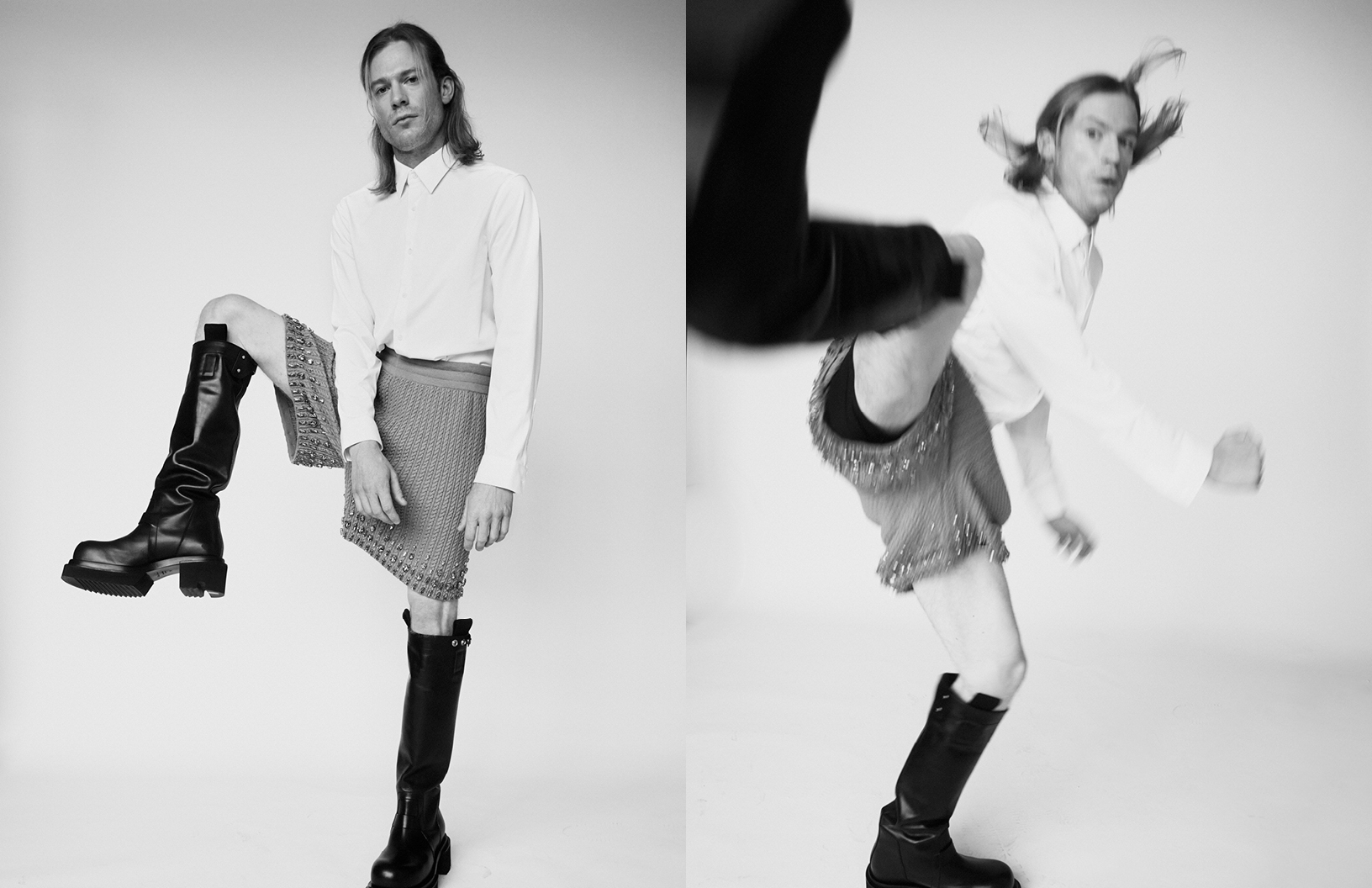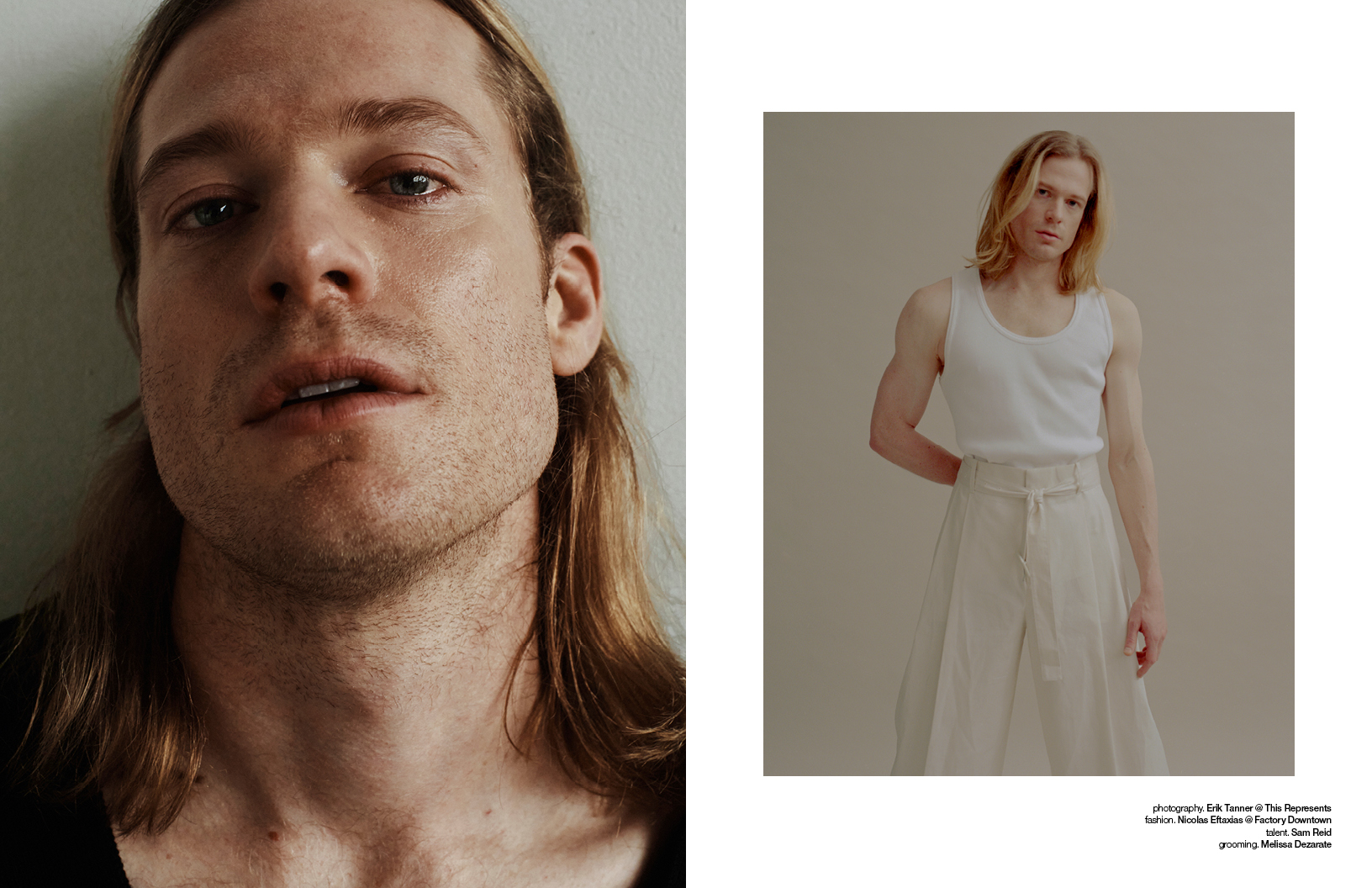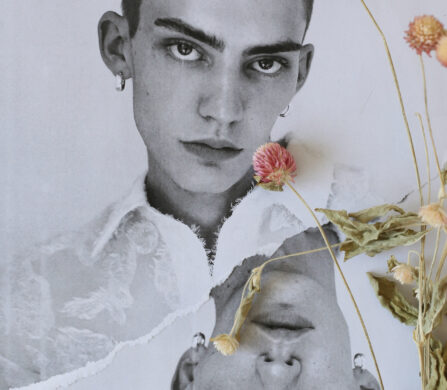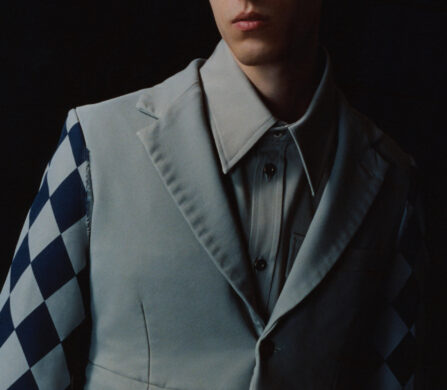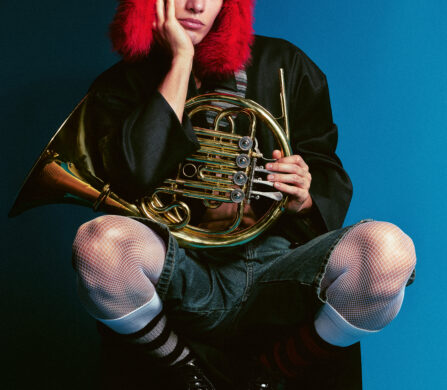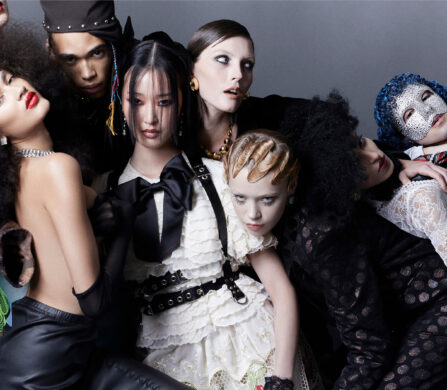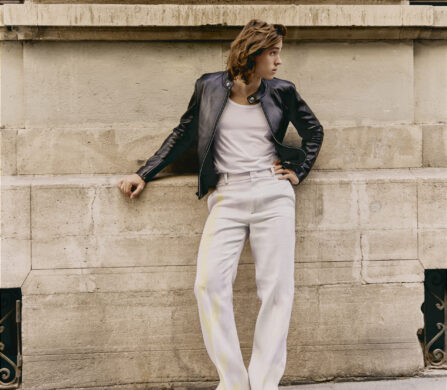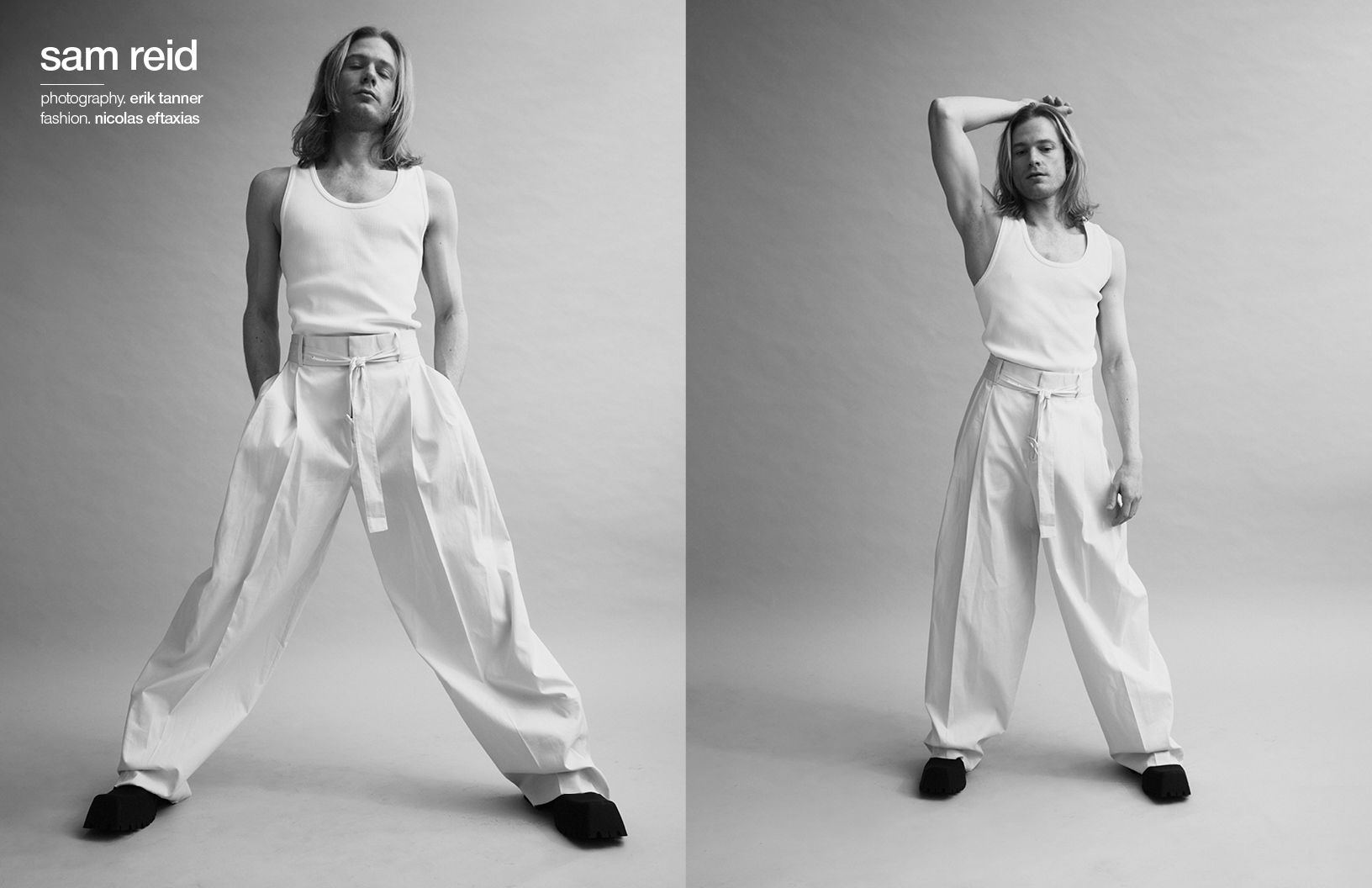
op + trousers. Bottega Veneta
shoes. Balenciaga
opposite
top + trousers. Bottega Veneta
shoes. Balenciaga
Vampires have been a cult item for years and they find their way back to the screens of the modern world from time to time. Get lost in the world of Sam Reid – the star of the series Interview With The Vampire which was released on AMC+ this fall and already is renewed for a second season. The show is based on Anne Rice’s iconic novel and Reid plays Lestat du Lioncourt, a vampire that is in a relationship with Louis de Pointe du Lac. A story of love, blood and immortality told by Louis to the journalist Daniel Molloy.
Sam chats to Schön! about playing Lestat, why he is drawn to darker roles, what superpower he would want to have and so much more.
Let’s start our interview with an introduction to the series Interview With The Vampire and your character. Can you tell us more about both?
So Interview With The Vampire is a TV show that is based on the works of Anne Rice. I play Lestat de Lioncourt who is a vampire. The book is told through the perspective of Louis de Pointe du Lac, who kind of explained it’s an interview between him and the investigative journalist Daniel Malloy, where he recounts his life and how he became a vampire. By Lestat because Lestat turned him into a vampire and they have a relationship. And there are a lot of dynamics that operate between the two of them. And season one is the first half of that book.
Before you started working on the show were you familiar with the original in which Tom Cruise is starring?
Yeah, I am aware of that film. We’re sort of doing an adaptation of the books of the Vampire Chronicles, which that film itself was also an adaptation of the first book within the Vampire Chronicles. I’m aware of the books, I read them when I was a kid. I revisited them once I was auditioning and preparing for the role. Now I feel like I have read nearly every book of hers — all of the vampire books — I’ve looked at every piece of media including all of the films and I love that 1994 movie. I appreciate Tom Cruise’s performance, I think he’s fantastic as Lestat. It’s a brilliant performance. I’m never trying to touch that, there are moments where I do like to pay a tiny homage to him because I think he’s sort of the original onscreen portrayal of Lestat.
We have the context of the whole series of books and there are 18 books within this world. We brought in new other elements of the character that weren’t present in that movie. He’s still the villain, he’s still dark and menacing. As the whole series and books evolve, he does go through a lot of different extreme circumstances to make him somewhat more self-reflective. We brought in elements of that character to allow us the room to be able to grow outside of just this sort of twisted, damaged villain, creature.
As you mentioned, there are 18 books. Is the first series based on the first book?
This series we’ve just finished is the first half of the first book.
That must be a very big book then.
Some of the books are quite big, over 500 pages. The first book is not one of the longest but they’re very dense. It’s a huge world that Anne Rice created. Roland Jones the show creator did this extraordinary job of capturing the tone and mood of those books and as well as sort of beefing up scenes that didn’t necessarily exist or was glossed over in the books a little bit.
Maybe you manifested playing in the series if you watched the movie as a kid, who knows? I always believe everything is connected.
I wanted to be a part of it when I heard that they were making it. I didn’t spend a lot of time like desperately wishing to play Lestat, per se. I have always been drawn to villains and darker characters. That’s always been the roles that I wanted to play were the ones that had darkness and were complex and complicated and not necessarily just a straightforward love interest. Lestat does tick a lot of boxes for me.
What’s the reason for you wanting to play these kinds of roles?
Maybe it’s because I’m quite a shy and reserved person. I think when you’re drawn to art and expression, it’s nice to do things that are the polar opposite of yourself. It’s a real challenge. It’s to try and work out how to tap into the side of you that you don’t know. I think with acting, it’s always sort of good to be terrified of it. It does require so much of you and takes so much of you that if it becomes boring, you don’t know what the exchange is for. If you’re terrified and every day you’re going to work to meet it like a battle. I think you want to understand the sacrifice that the job takes so I like to be challenged and scared of what I’m doing.
That’s interesting.
Playing a darker character means you spend a lot of time questioning and working out why this person is doing the things that he’s doing. That’s a really fun puzzle. I think a character like Lestat, there’s a lot of reasoning, there’s a lot of backstories, there’s a lot of clues in the works to explain why he is as menacing and vindictive and cruel as he is. It’s a wonderful challenge to try and bring humanity and empathy to such a dark character. Every day you’d sit and wonder, “how am I going to do this? How are we going to make people like him or me?”
I read about your character and just the way that he’s portrayed — really dark, very evil and doing everything just to get his lover Louis. At the end of the day, would you still think that there’s something in him that’s likeable?
It’s my job to try and find that. Since I love the books and I love the work of Anne Rice, you follow Lestat through all of these books and you get to know him very well. Particularly in the Interview with the Vampire, he doesn’t start as a particularly likeable character. As you follow those books, you do start to slowly understand his point of view. It’s easier to understand his motivations later on, but you need to bring that in from the beginning so it isn’t such a major shift if we start to see those seeds throughout the series.
Sometimes it’s nice to put the extremely villainous actions on screen and to be able to have a catharsis for an audience and the people making it present, that it can be done in a safe space and you can appreciate that because you don’t want to do these things in your real life. But it’s okay for a character to do it on screen and therefore you have an attachment to them because they are doing the darkest things that you could think of and they’re doing that for you, on your behalf.
I think that’s why Anne Rice’s work has been so popular because we’re looking at monsters through a human lens. Where do we draw the line between accepting what a monster can do? We say, well, that’s what monsters do but a human being would never do that. Then we ask ourselves how much do I identify with a monster and what does that say about me? I think these questions that she brings up all the time. As you approach them as an actor, it does the same thing. You start to be thankful that it is a monster. [laughs]
How did you prepare yourself for the role? Was there any specific research other than reading the books?
I always loved Dracula as a kid. Dracula was my favourite sort of monster. That’s what I was dressed up as on Halloween. I loved Gary Oldman in Francis Ford Coppola’s Dracula, so I did have an innate understanding of vampires. I did have an innate understanding of vampires. I really went back to the material and kept on going back to the source material all the time, and just carried around all the books and always referenced them as much as I possibly could.
In terms of the character, I had to learn French and singing lessons and piano lessons and that was quite a big transformation process, in addition to growing my hair out and having acrylic nails and contact lenses and fangs. It was a big process that happened gradually over time. It never felt too overwhelming but you feel it at the end of the day when you’re coming home at seven o’clock in the morning after working all night because we’ve worked during the night for six months. You feel like when you’re coming home you’re like, taking off all of this stuff. I was grateful that my hair had grown out and that I ended up getting acrylics and things that could stay on because the rigging of the character is such a process.
What was the most difficult thing to adapt to when playing your character?
I think shooting at night for six months is a bizarre thing. I don’t think you ever really get used to it.
What were the hours of the night?
You start work at about 4 pm and you finish at 7 am. You need to make sure you try and see that sort of hour of sunlight somehow a day, so you really try and trick your body into thinking day is night and sleeping during the day. They say that shift workers can go through a sort of psychosis because you’re working against your body clock and I think it’s why we all bonded so well as a crew. Everyone was so close because we’re all doing this crazy thing working.
You shot mostly in New Orleans which must have been a magical place to shoot at. What is your favourite memory that you take away from shooting there?
The great thing about shooting in New Orleans is that Anne Rice and New Orleans are so synonymous with each other. She’s such a cultural icon in that city and that city has so much identity wrapped around that city. It’s pretty extraordinary to shoot in the actual locations that you write about in the book and to walk around. When Jacob and I first arrived in New Orleans, we walked around the French Quarter and went to the buildings that we were going to shoot in. This is the actual house that Lestat lived in and we got to shoot in his actual house. Even shooting in City Park and having the Spanish moss kind of blowing over these extraordinary Oak Trees — there’s nothing quite like that city. It was an extraordinary transformative transporting experience to be in the actual locations where she was being inspired to write as well. It felt special.
That must have been so cool because I’ve never been there but maybe I’ll go one day. Let’s talk about the costumes and the wardrobe of your character. How did the costume designer Carol manage to reflect your character in your clothes?
With the clothes it was really interesting because we brought the story in the adaptation forward 100 years. That period from 1910 to the 1940s we struggled to work out what Lestat would be wearing because he’s described as a dandy and he loves his clothes and he loves fashion. I think he went through a bit of an awkward phase in the 1910s because he was trying to work it out. How do we create this sort of menacing figure with beautiful tailoring, but that’s not too outlandish? He’s got to stay within the parameters of pretending to be a human being in the first couple of episodes. What Carol did is she just took normal suits — beautiful pinstripe suits and dark suits — and then she just altered the tailoring. It was quite cool to watch how she’d bring in the waist, really, small and how she would put strips to make it look like bondage gear. She’d like to layer stripe on stripe on stripe to make it feel like he was oppressive like he was some sort of jail figure.
There were a lot of these subtle hints that she brought into the costume, like making things out of patent leather,. Then, as we get into the 30s and the 40s later on in the show, the clothes became a little bit more outlandish because Lestat was kind of having more fun I suppose. He wasn’t trying to hide as much. I think he enjoys that period a bit more. There was sort of like a vintage Hollywood glamour style that he sort of appreciated.
Yeah, I always love seeing the costumes from these periods because you learn so much about the history of that time as well.
The amount of research that she had going, how the clothes changed and adapted. I think throughout the whole season I had over 100 costume changes which is extraordinary on her part and the costume department’s. It’s sort of mind-blowing to grasp and that’s just one character.
Is there a favourite outfit that you can name from the top of your head?
One thing that I loved is these pyjamas. Originally we were in silk pyjamas and I didn’t feel that that was accurate to what he would wear. [laughs] I didn’t feel like Lestat when I wore these silk pyjamas. Carol invented this extraordinary pair of pants that we made multiple versions of that were high-waisted, loose pyjama pants that had sort of buttons down the front and then so I have multiple versions of them. I have them in black that I ended up wearing for a whole villain sequence because we thought they just look like a matador and we just thought we had this great sort of black-on-black Matador costume. I have those pants again in black and green stripes and in red. I wish that I took them but I didn’t.
Oh no. Were you even allowed to take anything?
I think if I asked they would have let me but what they did give me was my very bloody shirt from the season finale, which I still have kind of because it’s covered in a lot of mouth blood and sometimes if it’s really hot here because it’s really hot in Sydney. Sometimes the mouth blood liquefies again it becomes wet and stuff. It’s a really weird thing to have, I’ve got nowhere to put it. I have to hide it when I’ve got people coming to the house. [laughs]
Tell me more about the dynamic between Jacob and you who plays Louis, your love interest?
Jacob and I get on well, we have a close friendship. We bonded strongly throughout the making of this show. He’s one of my favourite scene partners I’ve ever had because it’s just such an easy working relationship. There’s a lot of trust between the two of us. You know, it’s a fucked up toxic relationship. It’s messed up. But at the core of it is like this intense, inescapable love. So, we have to play out a very morbid, obsessive, passionate relationship. I think it would be really hard to do if you hated the person opposite. I’m so grateful that we get on.
In a world that is influenced by vampires, and I think it was a bit more influenced maybe about like 10ish years ago when Twilight came out, The Vampire Diaries and all these shows. Would you say that vampires are still cool, or would you say they have lost their spark or will there always be something about them that people will question or want to know about?
I think Anne Rice brought vampires back into the mainstream. Obviously we have Bram Stoker’s Dracula, but Anne Rice did something very different. She put the vampire in the point of view of the audience in the narration of the point of view of the vampire. She brought that back into mainstream culture. There’s been a lot of vampire media that comes and goes and I think they’re all very influenced by Anne Rice, to be honest. I think they’re a perfect vessel to explore cultural themes at the moment. In terms of metaphor and the tool that they provide in storytelling, I think they’re awesome.
I don’t think we’re not living in an age where people need to see sparkly vampires right now. We’re living in a very fucked up period in the history of humanity. I think now is almost the perfect time to explore Anne Rice’s universe because she deals with a lot of these issues. She deals with issues like who am I and what is my core fundamental value. I think we’re all facing sort of an existential crisis with the environment. I think it’s sort of interesting to look at a being that lives forever. This is what I always found so interesting about the material; Vampires live forever yet they have to live within a human context. They have to live within human society because they live off human beings. I thought it was so interesting when I read the script for the first time. We had just gone through the most extreme bushfires in Australia and I grew up on a farm. We were there for this period. What does it mean to have to live under this being, to live under this in the society of human beings while they destroy the planet? What does it mean to live? I was thinking about all the other animals that have to live within this context, exploring a sentient emotional monster living in that context is quite interesting.
Yeah, you’re right. What is it an ability that vampires have that you would love to have yourself in real life? Other than maybe living forever?
I’d love to be able to fly. Anne Rice’s vampire can fly. But the way that they describe it is very terrifying. It’s like you’re out of control and you’re propelled by just sheer will. It’s a very scary experience. So, just by the nature of how they describe it, maybe I don’t want that but I’d love to have at least one go. [laughs]
Tell me more about what’s next for you. Will you stay in the supernatural world? Or are you drawn to something else? What’s on the radar right now?
Well, I just finished the second season of the News Reader, which is an Australian television show that I do which I love. I play completely the opposite character to Lestat, a very anxious man. I just finished that season but then we’re about to start the second season of our Interview with the Vampire so I will be in Lestats world for quite some time.
When are you starting to shoot it? The second one?
Next year. We’re shooting in Europe. I don’t think I’m allowed to say more than that.
What do you normally do when you’re not on set?
I like to do real things. I spend a lot of time in my imagination. It’s beneficial to do something real like getting out into nature or gardening. I grew up on a farm, I like to go out and do bush walks or get into nature. I’m just gardening basically in my house in Sydney. I just bought a house and I’m really getting into planting trees and plants and playing with my dog and just doing real things. Trying not to get caught up the in your head because your job is so much pretending.
Yeah, that sounds like a nice getaway if you’re not filming. My very last question is, do you personally believe in vampires?
I believe in what vampires represent. I think I strongly believe that there are very valuable cultural metaphors. But real vampires? No, but I do believe in people who identify as vampires. In New Orleans, 54 people live in New Orleans who identify as vampires. I believe in them. [laughs]
Interview with the Vampire is available to watch now on AMC+.
photography. Erik Tanner @ This Represents
fashion. Nicolas Eftaxias @ Factory Downtown
talent. Sam Reid
grooming. Melissa Dezarate
words. Maja Bebber


Schön! Magazine is now available in print at Amazon,
as ebook download + on any mobile device












